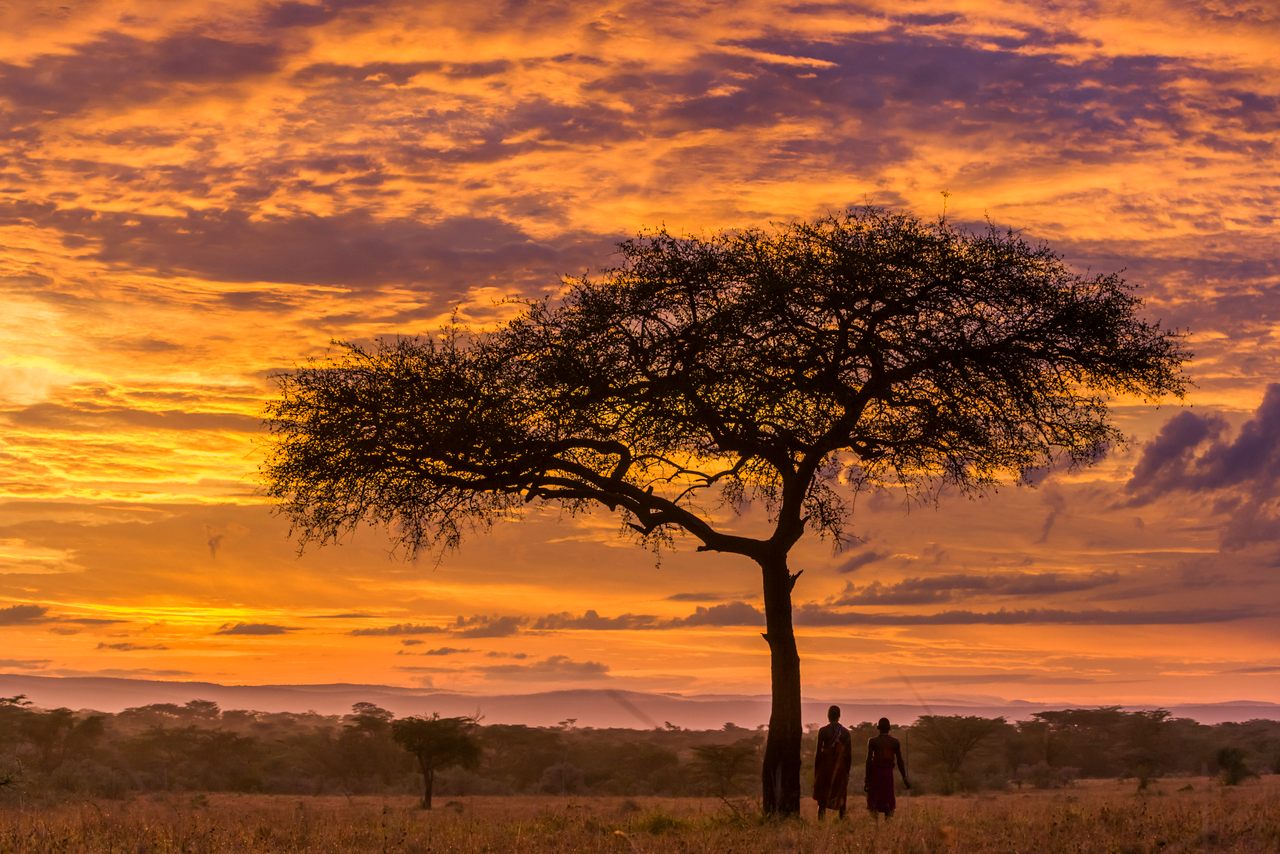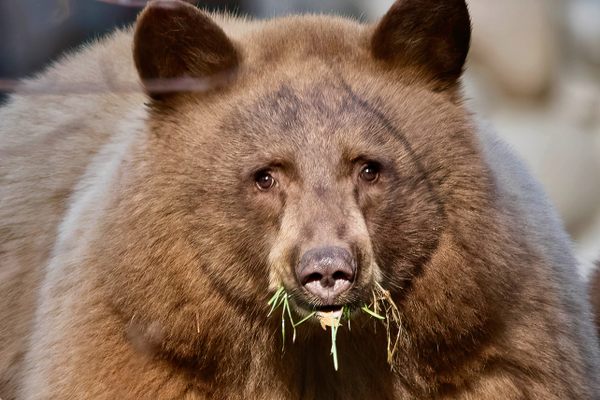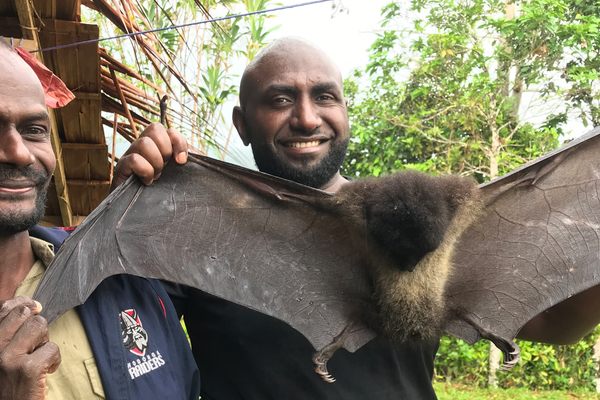The Resilience of Kenya’s Indigenous-Run Conservation Collective
Despite falling tourism and other woes, Kenya’s Il Ngwesi eco-lodge continues to provide for the community.
This piece was originally published in Yale E360 and appears here as part of our Climate Desk collaboration.
Africa’s most lauded Indigenous-owned eco-lodge, Il Ngwesi—which hosts rich tourists amid giraffes, elephants, and rhinos above a watering hole on the Laikipia plateau near Mount Kenya—is facing the toughest times in its 25-year history. The Covid pandemic has decimated bookings from the United States and Europe, as it has for tourism throughout sub-Saharan Africa. At the same time, drought has pushed cattle herds from neighboring tribes into its protected areas, and the lodge, run by the local Maasai tribe, faces reckless politicians stirring up land disputes and arming bandits.
On a continent where state-run parks often falter, the Il Ngwesi Eco-Lodge’s model of community conservation that integrates people and wildlife is increasingly seen as the best hope for Africa’s iconic megafauna. So can the lodge, which was founded in 1996, survive the pandemic and growing security threats in the months ahead with its borders, animals, and finances intact?
The pandemic has been disastrous for African wildlife tourism. Visits to Kenya crashed by more than 70 percent in 2020 and only gained back a sixth of the loss in 2021. Visitors to South Africa’s national parks were down 96 percent in the second quarter of 2020, with some recovery since. Conservationists have reported a surge in poaching as rural communities deprived of vital tourist revenues struggle to get by. Early in the pandemic, the Kenya Wildlife Service, which runs the country’s national parks, reported a 56 percent increase in seizures of illegally hunted bushmeat.

But Kirstin Johnson, of the Kenya-based African Wildlife Foundation, says eco-lodges, such as Il Ngwesi, that are run by Indigenous communities have proved more resilient to the economic downturn and less prone to poaching. They may not have the financial resources of big travel companies, but they make up for that in what she calls “the resilience of ancient pastoralist lifestyles” that depend on good management of open grasslands that benefits both wildlife and cattle.
During the lockdown, Johnson says, she visited three community conservation projects in Kenya, including Il Ngwesi. “They were expected to suffer worst from the collapse of tourism,” she says. “It’s been a very challenging time. But in all three, there were no reports of an upsurge in poaching. The wildlife was in good shape.”
The impact on tourism jobs in Africa has been “devastating,” according to the United Nations Development Program. Tens of thousands of jobs, everything from guides and wildlife managers to handicraft sellers and bartenders, have simply disappeared. And there may be long-lasting impacts if tourism revenues fail to recover, says Ramson Karmushu, research coordinator with the Kenya-based Indigenous Movement for Peace Advancement and Conflict Transformation (IMPACT), an Indigenous land-rights organization. “I foresee the pandemic affecting lifestyles and community culture into the future,” he said, with everyone from crafts sellers to herders and landowners suffering.
Kip Ole Polos, the Il Ngwesi lodge’s chairman, says “the pandemic hit us hard. At one point, we were forced to close down. But now we are fully open again. We have quite a few bookings. But we are reducing unnecessary costs to keep afloat.” He agrees that the collective cohesion of the lodge’s Maasai owners is its greatest strength. And his own story embodies what has been achieved in one of the most wild and remote areas of Kenya.
Ole Polos was born almost half a century ago in a boma, a livestock enclosure, on the plains of Laikipia in the center of the country, where his Il Ngwesi tribe of Maasai people raised cattle and fought gangs of poachers and cattle rustlers.
As a youth, he was initiated as a warrior. He was at first hostile when Ian Craig, a rich white settler who ran the neighboring Lewa ranch, suggested that the Il Ngwesi should follow his lead and turn their pastures into a wildlife “conservancy” that would be funded by foreign tourism. “I thought it was another way of somebody trying to grab our land. It took us almost two years to be convinced,” he says.

Maasai elders changed his mind. “We ended up volunteering 72 warriors to build the lodge with local materials,” he says. Today, a quarter-century on, Ole Polos is an elder himself, in charge of an enterprise where visitors pay upward of $200 per night for a pool, terrace bar, spa, and the chance to meet with Maasai and experience the savanna wilderness, with its resurgent populations of white rhinos, elephants, Grevy’s zebra, aardvarks, giraffes, impala, hyenas, jackals, lions, Cape buffalo, and leopards.
The lodge was initially financed by USAID as a pilot for community conservation in East Africa. Helping to guarantee the project in its early days, Craig was the first CEO. The link persists. Craig, a white inheritor of land taken in colonial times, gains good will and respect from his association with Indigenous tribespeople, and the Il Ngwesi tap into his connections, which have secured high-profile visitors such as Britain’s future king, Prince William. Craig also established the Northern Rangelands Trust, which, with funding from The Nature Conservancy and others, now coordinates security and conservation in 43 private and community conservancies covering an area of northern Kenya larger than the state of Delaware.
But the lodge is run by the community as a collective, with decisions on the land and lodge taken through resolutions in each of its seven villages and adopted by annual meetings of the community as a whole. About a third of the 8,000 Il Ngwesi people live within their 40,000-acre territory, half of which is set aside for conservation, with a buffer zone that can be used for cattle pasture during droughts. Most of the rest live on private farmland bought nearby either by the individuals or by the community to ease pressure on the conservation area.
Some 40 percent of the tourist revenue has been spent on development projects, health care, and paying for the children of cattle herders to go to school and even get university educations. Until the pandemic cut revenues by more than half, the remainder funded around 40 jobs running the lodge, tending the bush ecosystem, guiding visitors, and ensuring security.

The results over the past quarter-century have been dramatic, for both the Il Ngwesi people and their wildlife. “Since 1996, I have seen the vegetation coming back and the wildlife coming back,” says Ole Polos, who has been feted internationally, traveling regularly to drum up business for the lodge, raise funds for a planned fenced reserve for reintroducing black rhinos, and make the case for a form of conservation in which pastoralist communities such as his are part of the solution and not the problem.
“I want to bring nature back to how it was, with people living in it, benefiting from it, and with wildlife happy and big numbers coming back,” he says. The Il Ngwesi retain their livestock. “Cattle remain very important to the Maasai,” says Ole Polos. “To be a real man you have to have cattle. They are a symbol of wealth.”
But since the establishment of the lodge, there has been wealth in wildlife, too. Elephants used to rush through Il Ngwesi, fearing poachers, he says. Now they linger. “They understand that it’s safe and people who are herding animals are not their enemies.” The pandemic has put these advances in jeopardy. Staff have mostly been kept on, with reduced wages. But “lately a few have left to join other employment within the tourism industry.” His senior staff are in demand as guides to work for outside tour companies and other conservancies.
But there have been other threats, too. “The biggest challenge has been the drought, which hit hard on both pastoralists and wildlife,” Ole Polos says. “We did not have rains the whole of last year.” Drought threatens both their cattle and their wildlife. It also encourages invasions from neighboring pastoral communities, especially the Samburu tribes who graze drier land to the north and have traditionally seen the Laikipia plateau as a vital back-up resource.

Il Ngwesi maintains security against such threats with help from the Northern Rangelands Trust, which has become almost an alternative government in the area. This can be controversial. With state law enforcement fitful, self-policing by the armed rangers of the trust and its members, including Il Ngwesi’s former warriors, is often criticized. The Oakland Institute, a California-based think tank that focuses on land rights issues, published a report in November, Stealth Game, that claimed that, far from promoting community conservation, the trust underpinned “neo-colonial” safari tourism.
“Forty percent of Laikipia county’s land is occupied by large ranches, controlled by just 48 individuals—most of them white landowners,” the report noted. By running heavily armed security militias to keep Samburu raiders and their cattle off the Laikipia plateau, it stated, the trust was “ devastating” both the land and pastoralist communities in other areas.
“NRT has its failings,” admits Michael Dyer, a third-generation Kenyan who owns the Borana Conservancy and, as a white landowner, is one of the report’s targets. “But without it, things would be worse, particularly regarding ethnic clashes, and the potential for Al Shabaab [a terrorist group based over the border in Somalia] to recruit.”
The current conflicts between traditional pastoralism and tourist-funded “conservancies”—whether privately operated like Lewa and Borana, or Indigenous community operations like Il Ngwesi—have their roots in long-standing disputes about land that date back to the British colonial era, says Karmushu. The Il Ngwesi people only moved onto their current terrain around a century ago, after British settlers pushed them out of Meru county to the east.
Long-simmering resentment came to a head in 2016, when 60 bandits invaded the core conservation area around the Il Ngwesi lodge. Guests were evacuated by plane, and battle raged for five hours before the bandits retreated, leaving one of their number dead.
“The problem started when the Il Ngwesi lodge refused the Samburu access to the lodge for grazing,” one Il Ngwesi ranger told Jacques Pollini of McGill University, Canada, who was researching local land politics for a 2017 report with Karmushu. Another ranger said that in the old days, “during severe droughts, [the Samburu] used to move in a disciplined way… They sought permission. They would pay … Now they are not disciplined. They are armed, and they feel they can do what they like.” Ole Polos says he tries to negotiate with Samburu elders, but their youth do not listen.
Karmushu says the Samburu youth listen to—and are armed by—Laikipia politicians who hope to gain votes by fanning intercommunal conflicts and making promises of land. The area’s former member of Parliament, Mathew Lempurkel, publicly declared in 2017 that he was fighting a “third world war” against white settlers. He was arrested for inciting Samburu bandits during the 2018 elections, and again last September, after Samburu raids left eight people dead and hundreds displaced in the Ol Ari Nyiro Conservancy in northwest Laikipia, which is owned by Italian-born environmental activist Kuki Gallman. Lempurkel has announced he plans to attempt to regain his seat in Parliament in the general election this August.

But while politics inflames land disputes, “there are deep underlying issues,” Karmushu says. “This conflict … will not find solution as long as the stark contrast between large estates, well-endowed in grass and owned by rich settlers, and pastoralist communities impoverished by population growth, climate change and land dispossession, continues to exist.”
Ole Polos acknowledges that “this being a political year is going to be tough on us.” But his community is looking to the future. It believes it has secured future funding by leasing 200 hectares of its land to a so-far-unnamed foreign investor to put up a second eco-lodge with 40 beds. But as 2022 begins, the project is on hold.
Kenya’s tourism has always suffered booms and busts amid the country’s periodic violence and political turmoil. The pandemic has added a new layer of uncertainty. Some wonder if community conservation can survive and prosper in such an environment. But optimists see the pandemic as a one-off, and the raids, invasions, and political intrigue as a last gasp for an old way of life that will die as Kenya’s economy and stability advances — in part sustained by the attractions of its unique wildlife. And community control and management of the land and wildlife, they say, is the best way to secure that future.
















Follow us on Twitter to get the latest on the world's hidden wonders.
Like us on Facebook to get the latest on the world's hidden wonders.
Follow us on Twitter Like us on Facebook